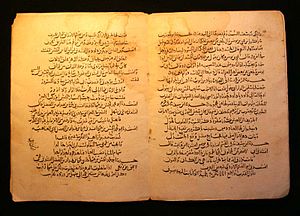Arrival of Islam
A manuscript written during the Abbasid Era.
Sindh became the easternmost province of the Umayyad and Abbasid Caliphate, referred to as "Al-Sindh" on Arab maps, with lands further east known as "Hind". Muhammad bin Qasim built the city of Mansura as his capital; the city then produced famous historical figures such as Abu Mashar Sindhi, Abu Ata Sindhi, Abu Raja Sindhi and Sind ibn Ali. At the port city of Debal most of the Bawarij embraced Islam and became known as Sindhi Sailors; they became famous due to their skills in: navigation, geography and languages. In fact, they inspired the One Thousand and One Nights character Sindbad the Sailor[11] ("And thence we fared on to the land of Sind, where also we bought and sold") and Sindbad-Nameh (Book of Sindbad). By the year 750 AD, Debal was second only to Basra; Sindhi sailors from the port city of Debal voyaged to Basra, Bushehr, Musqat, Aden, Kilwa, Zanzibar, Sofala, Malabar, Sri Lanka and Java, where Sindhi merchants were known as the Santri.
In the year 725, Junayad, the Abbasid Emir of Sindh, started an expedition from Nerun. He commanded a large army under the Abbasid flag, combining Arab-Sindhi cavalry. His army conquered the Temple of Somnath, and returned victorious.

No comments:
Post a Comment